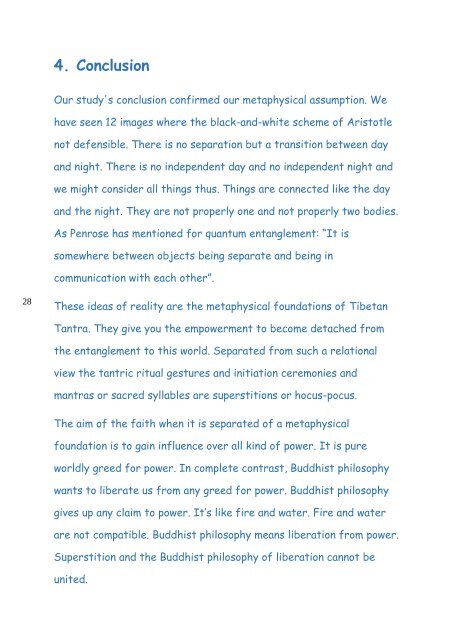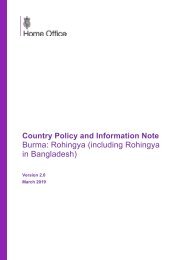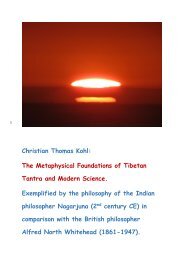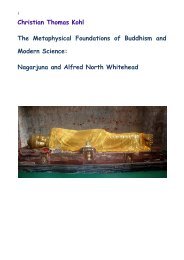Foundations of Tibetan Tantra
Abstract. By the 7th century a new form of Buddhism known as Tantrism had developed through the blend of Mahayana with popular folk belief and magic in northern India. Similar to Hindu Tantrism, which arose about the same time, Buddhist Tantrism differs from Mahayana in its strong emphasis on sacramental action. Also known as Vajrayana, the Diamond Vehicle, Tantrism is an esoteric tradition. Its initiation ceremonies involve entry into a mandala, a mystic circle or symbolic map of the spiritual universe. Also important in Tantrism is the use of mudras, or ritual gestures, and mantras, or sacred syllables, which are repeatedly chanted and used as a focus for meditation. Vajrayana became the dominant form of Buddhism in Tibet and was also transmitted through China to Japan, where it continues to be practiced by the Shingon sect. This is the usual understanding of Tibetan Tantra. With a feeling of great dismay, I regret to say that this is an understanding without any foundation. This is nothing more than an exotic superstition when separated from its metaphysical foundations. What Alfred North Whitehead tells us about Christianity can be transmitted with small changes to Buddhism. Whitehead says: "Christianity would long ago have sunk into a noxious superstition, apart from the Levantine and European intellectual movement, sustained from the very beginning until now. This intellectual movement is the effort of Reason to provide an accurate system of theology. Indeed, in outlying districts where this effort at rationalization died away, the religion has in fact sunk into the decrepitude of failure" (A.N.Whitehead, Adventures of Ideas, The Free Press Paperback Edition 1967, page 162). In this short history in images I will present the Metaphysical Foundations of Tibetan Tantra. That is mainly the philosophy of the Indian philosopher Nagarjuna (2nd century CE) in comparison to the British philosopher Alfred North Whitehead (1861-1947). [The end of the abstract]
Abstract.
By the 7th century a new form of Buddhism known as Tantrism had developed through the blend of Mahayana with popular folk belief and magic in northern India. Similar to Hindu Tantrism, which arose about the same time, Buddhist Tantrism differs from Mahayana in its strong emphasis on sacramental action. Also known as Vajrayana, the Diamond Vehicle, Tantrism is an esoteric tradition. Its initiation ceremonies involve entry into a mandala, a mystic circle or symbolic map of the spiritual universe. Also important in Tantrism is the use of mudras, or ritual gestures, and mantras, or sacred syllables, which are repeatedly chanted and used as a focus for meditation. Vajrayana became the dominant form of Buddhism in Tibet and was also transmitted through China to Japan, where it continues to be practiced by the Shingon sect.
This is the usual understanding of Tibetan Tantra. With a feeling of great dismay, I regret to say that this is an understanding without any foundation. This is nothing more than an exotic superstition when separated from its metaphysical foundations.
What Alfred North Whitehead tells us about Christianity can be transmitted with small changes to Buddhism. Whitehead says: "Christianity would long ago have sunk into a noxious superstition, apart from the Levantine and European intellectual movement, sustained from the very beginning until now. This intellectual movement is the effort of Reason to provide an accurate system of theology. Indeed, in outlying districts where this effort at rationalization died away, the religion has in fact sunk into the decrepitude of failure" (A.N.Whitehead, Adventures of Ideas, The Free Press Paperback Edition 1967, page 162).
In this short history in images I will present the Metaphysical Foundations of Tibetan Tantra. That is mainly the philosophy of the Indian philosopher Nagarjuna (2nd century CE) in comparison to the British philosopher Alfred North Whitehead (1861-1947).
[The end of the abstract]
You also want an ePaper? Increase the reach of your titles
YUMPU automatically turns print PDFs into web optimized ePapers that Google loves.
4. Conclusion<br />
Our study's conclusion confirmed our metaphysical assumption. We<br />
have seen 12 images where the black-and-white scheme <strong>of</strong> Aristotle<br />
not defensible. There is no separation but a transition between day<br />
and night. There is no independent day and no independent night and<br />
we might consider all things thus. Things are connected like the day<br />
and the night. They are not properly one and not properly two bodies.<br />
As Penrose has mentioned for quantum entanglement: “It is<br />
somewhere between objects being separate and being in<br />
communication with each other”.<br />
28<br />
These ideas <strong>of</strong> reality are the metaphysical foundations <strong>of</strong> <strong>Tibetan</strong><br />
<strong>Tantra</strong>. They give you the empowerment to become detached from<br />
the entanglement to this world. Separated from such a relational<br />
view the tantric ritual gestures and initiation ceremonies and<br />
mantras or sacred syllables are superstitions or hocus-pocus.<br />
The aim <strong>of</strong> the faith when it is separated <strong>of</strong> a metaphysical<br />
foundation is to gain influence over all kind <strong>of</strong> power. It is pure<br />
worldly greed for power. In complete contrast, Buddhist philosophy<br />
wants to liberate us from any greed for power. Buddhist philosophy<br />
gives up any claim to power. It’s like fire and water. Fire and water<br />
are not compatible. Buddhist philosophy means liberation from power.<br />
Superstition and the Buddhist philosophy <strong>of</strong> liberation cannot be<br />
united.

















